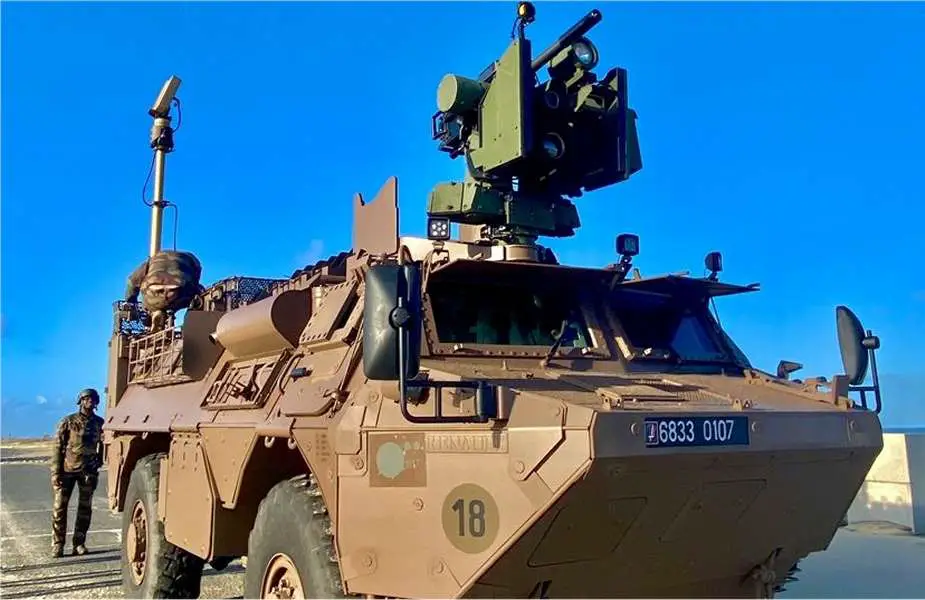Breaking news
New VAB ARLAD Anti-Drone Combat Vehicle Enters Into Service with French Army.
The French Army has officially deployed its first VAB ARLAD anti-drone combat vehicles, a move that marks a significant enhancement of its anti-drone warfare capabilities. Announced by the French Army's Technical Section (STAT) on April 13, 2024, the VAB ARLAD entered into service at the French Army All-Arms Air Defense Training Center (LATTA) under the 17th Artillery Group in Biscarosse, in southwestern France.
Follow Army Recognition on Google News at this link

The VAB ARLAD is the new counter-drone armored vehicle of the French Army. (Picture source French army STAT)
Developed in response to urgent operational needs, the VAB ARLAD is designed to improve the French Army's defenses against increasingly prevalent drone threats on the battlefield. The vehicle is equipped with advanced technologies, including a 12.7 mm machine gun modified with an "airburst" capability via a 40 mm grenade launcher and a sophisticated radar system capable of detecting drones from up to 2500 meters away.
Despite the advanced capabilities of the VAB ARLAD, concerns have been raised about the adequacy of the fleet size. With only 12 units entering service, deputies Jean-Louis Thiériot and Natalia Pouzyreff have criticized the deployment as insufficient to equip the ground forces coherently. However, the Military Programming Law (LPM) for 2024-2030 includes plans to enhance the Ground Forces' anti-air defenses further with the addition of 36 VBMR-L Serval vehicles, including 24 equipped with MISTRAL missile systems, demonstrating France's commitment to bolstering its defensive capabilities against aerial threats."
The VAB ARLAD anti-drone combat system represents a state-of-the-art modification of the traditional VAB, a wheeled armored vehicle in service with the French army in several configurations. This system integrates a sophisticated drone detection radar, mounted on a telescopic mast for enhanced visibility and tracking capabilities. It is armed with a remotely operated turret featuring an M151 Protector automatic machine gun, capable of firing 12.7 mm rounds. Additionally, the vehicle can be also armed with a 40 mm grenade launcher, able to fire airburst ammunition. This combination of firepower and advanced surveillance technology allows the VAB ARLAD to effectively neutralize drone threats, providing a significant boost to anti-drone defense measures in combat scenarios.
Airburst ammunition is particularly effective against drones due to its unique detonation mechanism, which allows it to explode in the air near the target. This capability is especially advantageous when dealing with small, fast-moving, and agile targets like drones. Unlike traditional ammunition, which requires a direct hit to incapacitate or destroy a target, airburst rounds are engineered to detonate at a predetermined distance from the target, maximizing the likelihood of disabling or eliminating the drone even without a direct impact.
The process begins with the drone being detected and its trajectory tracked using radar or other sensor systems. Once the target is acquired, the airburst round is fired along a calculated trajectory that intercepts the drone's path. The key to its effectiveness lies in the timing of the explosion, which is meticulously controlled to maximize the spread of shrapnel at the optimal moment, thereby increasing the chances of striking the fast-moving drone. This method of engagement allows for a higher probability of neutralization, making airburst ammunition a highly valuable asset in modern anti-drone warfare.

The VAB ARLAD is armed with a remotely operated weapon station armed with one 40mm automatic grenade launcher able to fire airburst ammunition. (Picture source French STAT)
The intensive use of drones in conflicts like the one in Ukraine has underscored the strategic importance and effectiveness of unmanned aerial systems (UAS) on the modern battlefield. Drones provide several advantages, including surveillance, direct attack capability, and the ability to disrupt enemy operations without risking human lives directly. This extensive deployment and the resultant tactical shifts have dramatically accelerated the demand for effective countermeasures, such as anti-drone vehicles.
In response to this evolving threat landscape, many armed forces worldwide, including the French Army, have recognized the urgent need to enhance their capabilities to counter hostile drones. This has led to an increased demand for vehicles equipped with anti-drone systems, capable of detecting, tracking, and neutralizing drones.
Recognizing the necessity to adapt to this new form of warfare, the French Army has launched specific programs to develop and deploy vehicles like the VAB ARLAD. The VAB ARLAD is specially designed to address the challenges posed by drone threats through features like advanced detection radars and airburst ammunition systems. These vehicles are capable of operating in various environments where drones might be used, providing a crucial layer of defense against the increasingly sophisticated drone operations witnessed in conflict zones such as Ukraine.
The deployment of such systems is not just a response to immediate threats but also a strategic move to prepare for future conflicts where drone technology might play an even more central role. By investing in and deploying anti-drone vehicles, the French Army aims to ensure it remains capable of defending its forces and interests against all forms of aerial threats, thereby maintaining operational superiority and protecting personnel on the ground.
Defense News April 2024


























